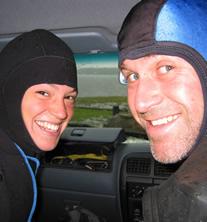Invasive Species and Native Australian Clams

Using funds from the International Research Opportunities Program (IROP), ecology, evolution and behavior student Lena Collins studied the effect of Caulerpa taxifolia on native clams in Wollongong, Australia. An invasive seaweed, Caulerpa taxifolia grows everywhere from the surface of the ocean to the lower limits of underwater vegetation. Because this alga spreads by fragmentation and vegetative growth and is toxic to many grazers, it is nearly impossible to stop Caulerpa’s spread. It now covers thousands of acres in the Mediterranean Sea, as well as being present in Australia and California.
To study the impact of Caulerpa taxifolia on the vulnerability of Anadara trapezia to predators and parasites, Lena performed research at St. George’s Basin, Australia. She placed 24 cages containing 10 clams each inside and outside of Caulerpa taxifolia beds and assessed the clams’ mortality and health over a five-week period. She also collected clams from three different habitats—bare sediment, native seagrass, and Caulerpa taxifolia beds—and noticed distinct differences in parasite damage, the most occurring in the Caulerpa beds.
Assistant Professor James Byers of the zoology department served as Lena’s UNH mentor, and she studied alongside University of Wollongong Professor Jeff Wright in Australia.
